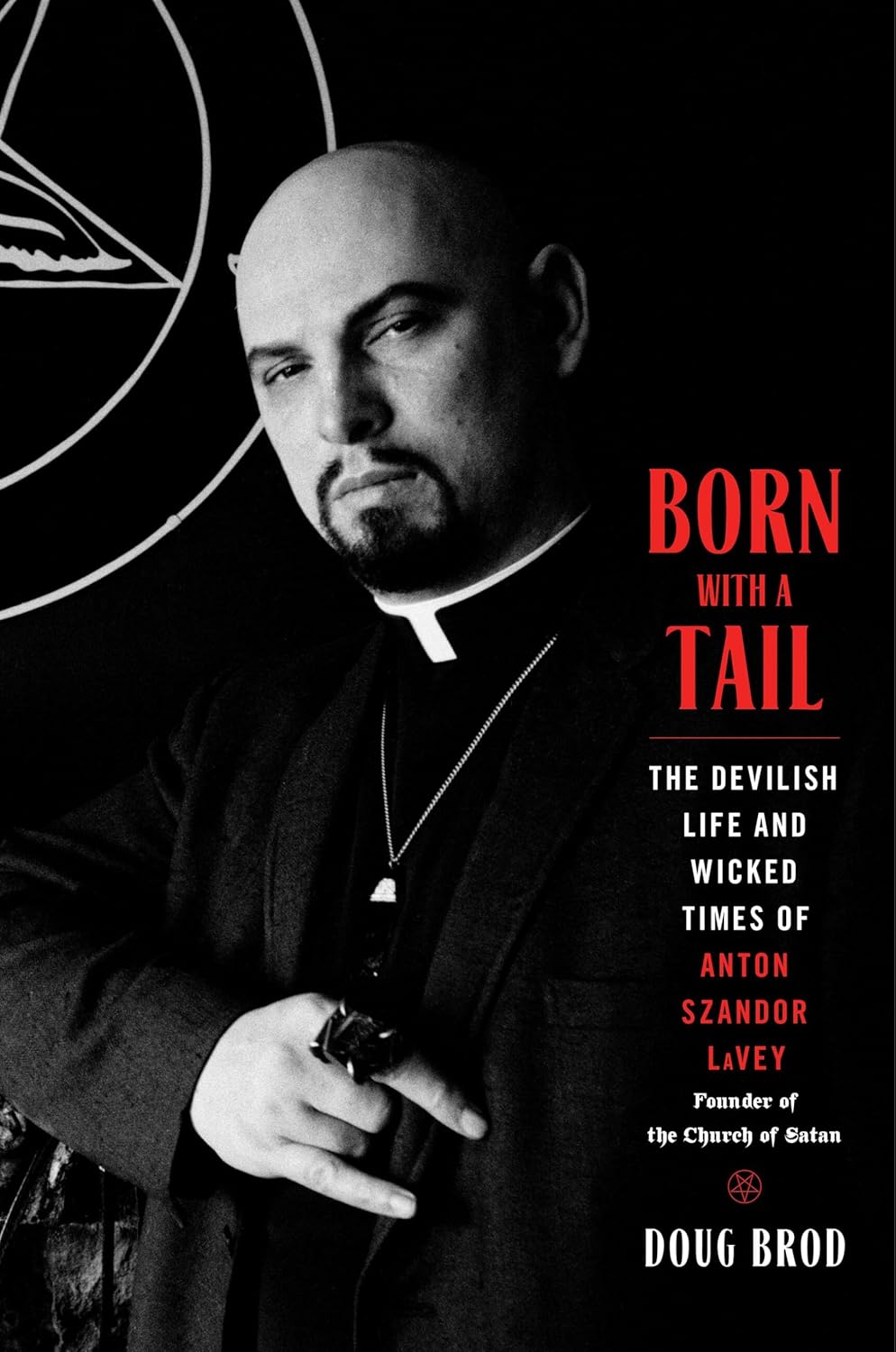Born with a Tail: The Devilish Life and Wicked Times of Anton Szandor LaVey, Founder of the Church of Satan
- By Doug Brod
- Grand Central Publishing
- 368 pp.
- Reviewed by Chris Rutledge
- October 31, 2024
Did the diabolical huckster actually buy what he was selling?

Born with a Tail provides a glimpse into the life of Anton LaVey, founder of the Church of Satan and an all-around scandalizer of polite society. The book’s subject lived as a skeptic of traditional faith systems; readers would be well-served to approach his biography with a similarly arched eyebrow.
Author Doug Brod brings to this effort a lifetime of experience writing about the intersection of pop culture and Lucifer-lite. A former editor of Spin, Entertainment Weekly, and TV Guide, Brod is also the author of They Just Seem a Little Weird: How Kiss, Cheap Trick, Aerosmith, and Starz Remade Rock and Roll, which chronicled a handful of bands’ impact on music — and, more broadly, us — in the 1980s and 90s.
Anton LaVey (1930-1997) was a complicated man. Yes, he launched the Church of Satan, but he was also a showman and a notorious conman, and his focus was on his finances far more than on any principled spiritual stance. Brod quotes historian Lawrence Wright, who said of sci-fi novelist and Church of Scientology founder L. Ron Hubbard that while Hubbard “took his self-generated faith as gospel,” LaVey never “crossed the line into believing his own bullshit.”
Brod also quotes from LaVey’s FBI file, which notes that “he was well aware that most people associated with the Church of Satan are in fact fanatics, cultists, and weirdos. LaVey himself reported to the agents that his interest in the Church of Satan was ‘strictly from a monetary point of view.’”
And monetize the church he did. One fateful evening, Brod recounts, LaVey “performed (a Satanic wedding) ceremony no fewer than five consecutive times…under oppressively hot lights, for the benefit of television cameras and international news agencies.”
He adds that “LaVey didn’t miss an opportunity to promote the hell out of his ninety-five-cent paperback, whose first printing was a generous 125,000 copies.” This media blitz included interviews with Phil Donahue and Art Linkletter and on local radio. He was also featured in print outlets as varied as McCall’s and London’s Daily Telegraph Magazine. LaVey knew how to leverage the press.
A musician, LaVey claimed to have followers and lovers among the elite and said he’d had many careers, including as a calliope player for the Clyde Beatty Circus and an organist for strippers. This may be where he first found his taste for showy women, two of whom — Marilyn Monroe and Jayne Mansfield — he bragged to have bedded.
Despite these carnal distractions, LaVey insisted he was a dedicated father, albeit one incapable of keeping his offspring in his orbit. His estranged daughter Zeena, seeing through his act, had a tendency to take up with Dad’s enemies, often joining them in challenging LaVey for control of the Church of Satan’s funds.
Given how flashy, colorful, and salacious LaVey apparently was, it’s odd how little Born with a Tail gets from the man himself. Although Brod fleshes out his subject via publicly available quotes, we’re left with a series of anecdotes rather than any real insight into LaVey’s inner life and motivations. Surely, he was propelled by something other than just the next grift? If not, why bother writing an entire book about him? As it stands, the reader will be forgiven for asking, “Isn’t there more?”
Yes, some seeds are there. For example, LaVey’s flirtation with Nazism is touched on. “LaVey (couldn’t) resist wandering into you-gotta-hand-it-to-Hitler territory,” writes Brod, “praising the Nazi strongman’s concept of Strength Through Joy.” And “FBI files indicated that, in September 1973, he was listed in a computer printout list of those described as interested in the…National Socialist White People’s Party.”
But these revelations come a bit late and aren’t thoroughly considered. It may be true that LaVey saw the swastika and the Confederate flag, which he kept by his desk, as nothing more than “symbols of power and aggression.” But where did this dismissive attitude toward these verifiably sinister icons come from? Again, so much grist is left on the mill floor.
Perhaps most disappointing, Brod says little about the reality that, while LaVey prioritized scams over valid discourse, he did rightly note that Christianity and other faith systems rely on a facile “Do as I say, not as I do” and “Be a good sheep, don’t ask questions” philosophy. Doesn’t this suggest at least a degree of reflection on LaVey’s part and a partial rationale for inventing the Church of Satan? If the answer is knowable, Born with a Tail doesn’t really provide it.
Chris Rutledge is a husband, father, writer, nonprofit professional, and community member living in Silver Spring, MD. Besides the Independent, his work has appeared in Kirkus Reviews, American Book Review, and countless intemperate Facebook posts, which will surely get him into trouble one day.

